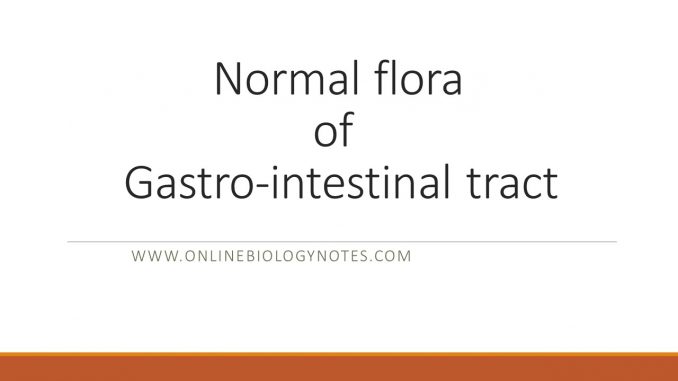
Normal flora of Gastrointestinal tract
- GI tracts consists of stomach, small intestine and large intestine. Various parts of GI tract differ in their environmental characteristics, chemical compositions and physiological properties. Therefore types and number of microflora vary in different parts.
- In general number of microorganisms increases from stomach to small intestine to large intestine.
Normal flora of stomach:
- Stomach receive large number of microorganism from mouth along with food and water but antimicrobial activity of HCl kills most of them. Few microorganisms that can tolerate acidity of stomach can form resident normal flora of stomach.
- Examples: lactobacillus, Candida albicans, Helicobacter pylori, lactobacillus, Enterococcus etc
- Number of microorganisms in stomach increases immediately after ingestion of food but number soon decreases after gastric juice is secreted.
Normal flora of small intestine:
- Duodenum is adjacent to stomach and hence it is slightly acidic in nature. Therefore microorganisms in duodenum is similar to that of stomach. Mainly Lactobacillus and Enterococcus are found in deuodenum.
- From duodenum ileum, intestine become less acidic and hence number of microorganism increases.
- In jejunum Enterococci, lactobacillus, Diphtheroid and Candida albicans are found.
- In Ileum microorganism begins to resemble to that of large intestine. Mainly obligate anaerobes such as Clostridium perfinges, Bacteroides and anaerobic E. coli are found.
Normal flora of large intestine:
- Large intestine is anaerobic in nature. It contains obligate anaerobes and facultative anaerobes.
- Clostridium perfingens, Bifidobacterium, Bacteroides, Streptococcus fecalis, E. coli
Factors that influences number and types of normal flora in GI tracts:
- Diet: Types of foods affects number and types of microflora in GI tract. In vegetarian diet the number of sacchrolytic microorganism such as E. coli increases and if meat is consumed proteolytic organism such as Clostridium
- HCl and Bile: HCl in stomach and bile in duodenum are antimicrobial so the number of microorganisms is lower in stomach and duodenum than other GI tract.
- Antibiotics: if antibiotics is taken orally the number of microorganism decreases. Prolong antibiotic therapy decreases significant number of microflora of GI tract.
- Physiological condition: during diarrhea number of microbiota decreases due to washing of intestinal tract.
Role of Intestinal normal flora:
- Synthesize vitamin B12 and vitamin K
- Produces various carbohydrate metabolizing enzymesand helps in food digestion. Eg. Cellulase, glucosidase, galactosidase
- Helps in steroid metabolism
- Produces gases such as CH4 and CO2
- Produces other substances such as Indole, Skatole, butyric acid etc.
